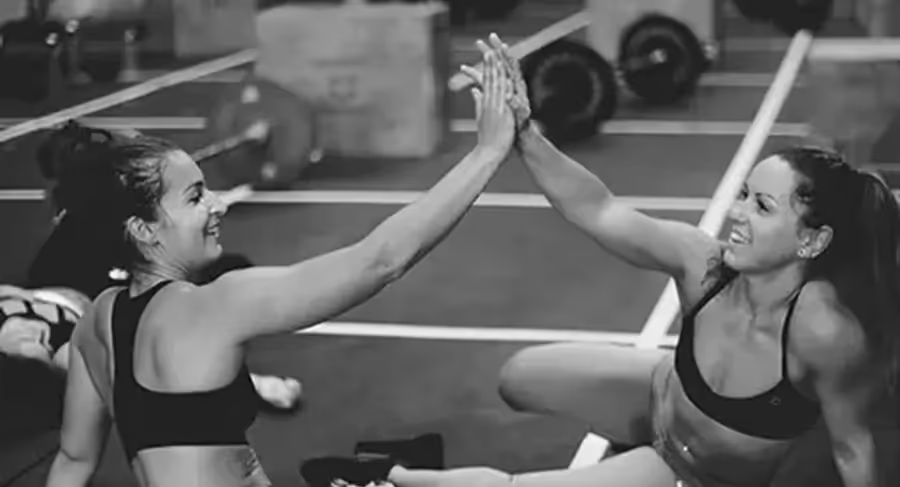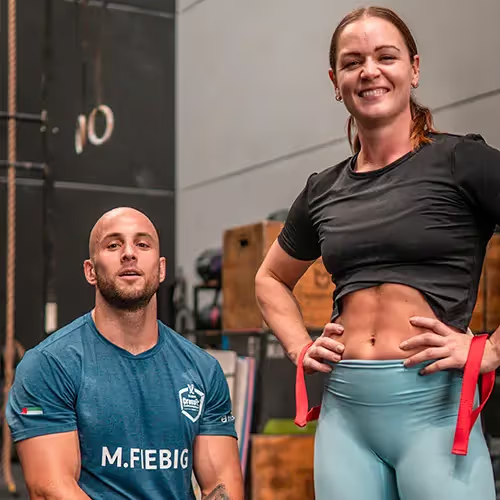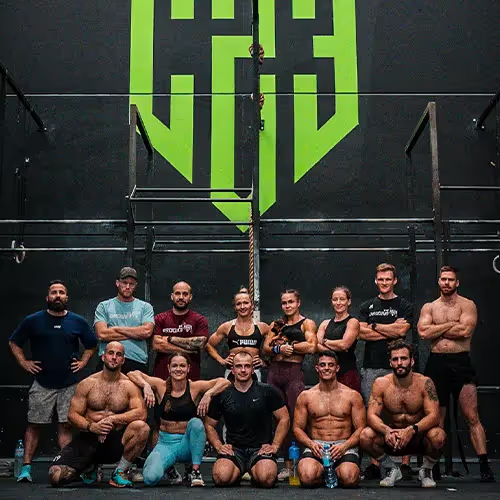Partner WODs
Try these CrossFit Partner WODs and discover the joy of shared challenges and camaraderie. I-Go-You-Go, relay and synchro workouts.



Try these CrossFit Partner WODs and discover the joy of shared challenges and camaraderie. I-Go-You-Go, relay and synchro workouts.


Part of what makes CrossFit classes or training in groups so much more enjoyable than training solo is the competitive camaraderie aspect of it.
Having someone to keep up with brings out your best performance during a workout, and overcoming challenges forging strong connections with your fellow athletes.
You can get the full experience by taking on a workout with a partner or in a team.
Let’s have a look at the advantages of Partner WODs, the various formats they come in, effective strategies to tackle them, and key skills to work on for successful collaboration.
A Partner WOD is a workout that is designed to be completed by 2+ athletes. These workouts are usually long, and have 2-3 times the volume of a workout designed for individual athletes. Partners are required to work simultaneously or divide the work between them to complete the workout with the fastest time possible or accumulate as many reps as possible or most weight lifted.

Partner workouts can use one of the following formats to dictate who should do prescribed work, and when. Sometimes workouts can also use a combination of these formats:
This is probably the most common style of partner workout, YGIG involves alternating efforts between partners. One partner works while the other rests until the work is done.
This structure requires effective communication before and during the WOD to ensure the best performance.
This work to rest element allows for a brief but valuable recovery period between efforts, helping to maintain intensity throughout the entire workout.
How the work is divided is usually decided by the athletes. The advantage of this is that the workload can be distributed strategically based on each partner's strengths and weaknesses.
Try one of these YGIG workouts:
For Time:
2 km Row
100 Alternating DB Hang Clean & Jerk (22.5/15 kg)
300 Double Unders
100 Alternating DB Snatch (22.5/15 kg)
50 HSPU
2 km Row
3 Rounds for Time:
40 Burpee Box Jump Over
30 Squat Cleans (80/60 kg)
20 Wall Walks
10 Rope Climbs
For Time:
100 Thrusters (50/35 kg)
* Every time you switch: 10 Synchro Sit ups
100 cal Assault Bike
* Every time you switch: 10 Synchro Jump Squats
Similar to I-Go-You-Go, in a relay only one athlete can work at a time, however there is a set amount of work that must be done to change when partners alternate efforts.
Usually, athletes must alternate after every exercise, round, or time window. Having clearly defined transitions creates a seamless, fast-paced dynamic.
This dynamic format introduces an additional layer of strategy, communication, and coordination between the athletes.
As one partner completes their portion of the workout, the other seamlessly steps in to perform their designated tasks.

Since the work of each athlete is prescribed, the athletes can’t rely on their partner to account for their weaknesses. The workload is also more likely to be equal between the athletes.
Here are some examples of Relay Style WODs:
Partner Cindy
AMRAP in 20 minutes
5 Pull-Ups
10 Push-Ups
15 Air Squats
In relay style with one athlete working at a time to complete the entire round the other athlete can begin.
Lift Run Relay (Adapted from 2023 CrossFit Games, Event 5)
6 Rounds For time:
10 Snatches (61/43 kg)
400-m Run
*Partners alternate rounds
Fight Gone Bad Relay
4 Rounds For Total Reps in 20 minutes
1 minute Wall Ball Shots (20/14 lb)
1 minute Sumo Deadlift High-Pulls (75/55 lb)
1 minute Box Jumps (20 in)
1 minute Push Press (75/55 lb)
1 minute Row (calories)
* Partners alternate exercises each minute.
Synchronized, or "synchro," movements in CrossFit Partner WODs involve both partners performing specific exercises in unison.
The exercises should be visually synchronized, meaning that partners need to move together to hit key positions in the exercise for the rep to count (for example in a synchro toes to bar, the feet of each athlete should make contact with the bar at the same time).
This requires precision with timing communication, and being able to anticipate your partner’s movements. Common synchro exercises include wall balls, kettlebell swings, burpees, bar gymnastics, barbell cycling, and dumbbell exercises.
Exercises athletes will perform and exercise simultaneously (like running), or will share equipment to move in unison (like using a single bar to do partner deadlifts, or a single medicine ball to do partner wall balls).
Practice your synchro skills with one of these workouts:
For Time:
50 Synchro Thrusters (43/29 kg)
40 Synchro Sit ups
30 Synchro T2B
20 Synchro Target Burpees
10 Synchro Bar Muscle ups
AMRAP 22'
800m Run (together)
20 Synchro Wall Balls
20 Synchro Kettlebell Swings (24/16 kg)
20 Partner Push ups
Doing partner workouts can elevate your own fitness journey on a few different levels:
Partner workouts make you feel accountable: You’re more likely to push yourself harder for longer knowing that your partner is counting on you to get the work done. This feeling of responsibility is intuitive and can be surprisingly motivating even for people who aren’t competitive. It’s not about “winning” or getting the best score, it’s about giving your best effort because your partner is doing the same.
Partner workouts allow you to specialize: In order to score high, it’s in the team’s best interest to divide the work in a way that best uses each athlete’s strengths. That could mean that each athlete will be able to showcase their strengths, and possibly avoid their weaknesses given that their partner will take on the brunt of the work. It can also be an educational way to see first-hand how your peers perform skills that you perform differently.

Partner workouts are motivating: The sense of camaraderie that’s normally felt when individuals do the same WOD is amplified by 10 when the work is in pairs. Everyone pushes harder, but the intensity and sense of urgency is also elevated when your partner is your face, cheering you on.Plus, the shared experience of overcoming challenges with a friend adds an extra layer of enjoyment to your training sessions.
Working out with a teammate can help you push past your own boundaries in a unique way that's different from training individually. That said, partner workouts are the most enjoyable when the partners feel like they are working together and doing well. Here are some tips to make sure that you work hard together, and have fun.
Setting a rhythm is essential both before and during the workout. Before 3,2,1 go!, make sure that you and your partner are on the same page about the goals you each have for the WOD. For a harmonious partnership, you’ll need to agree if the aim is to top the leaderboard, or to just move and have fun. This is also the best time to mention if there are any injuries or pains to take into consideration.
Before the WOD establish a strategy including cues for transitions, division of reps, and a plan for tackling the challenging movements. During the workout, speak to each other and use eye contact if it’s necessary to adjust the plan. Even when resting, you should always be paying attention in case you have to jump in or prepare equipment. When you’re working, give your partner a heads up before you stop moving so that they can be ready to take over without hesitation.
Understanding your partner's strengths and weaknesses allows you to assign tasks that will optimize the team’s performance. For example, if one excels at gymnastics they can take on the bulk of the exercises like muscle ups or handstand push-ups, while the other focuses on lifting or cardio. Don’t forget to account for transitions and fatigue.
Partner WODs often involve high-intensity efforts, so pacing is crucial. Maintain a consistent effort level throughout to avoid burnout and ensure both partners contribute equally. Plan strategic rest breaks to ensure both partners stay fresh. Understanding when to push and when to recover is essential for sustaining a strong performance throughout the entire workout.
If you want to take your partner WOD game up a notch, or if you’re interested in competing as part of a team, there are a few skills that can make or break a good partnership. These are the skills that you you practice regularly with your partner (or team!):
Synchronized Movements: Perfecting movements that require synchronization, such as pull ups, wall balls, or burpees, will give you a competitive edge in Partner WODs. Work on these exercises regularly to know which athlete leads and what your pacing should be like. The more in tune you are with your partner's rhythm, the more efficiently you can perform the workout.
Team Transitions: Smooth transitions between partners and exercises are essential to cut down on wasted time. Practice seamless handoffs of equipment, mounting and dismounting cardio machines, and quick communication to minimize stalling and hesitation.
Adaptability: Even if you have a plan going into the workout, it’s crucial to be able to adapt as necessary. You never know what might come up in the middle of a workout, so being able to adjust your strategy mid-WOD is a valuable skill that comes with knowing yourself and your partner’s habits, abilities, and capacity.
Now that you've been briefed, here are 5 Partner WODs that you can try out. Grab a friend (or a rival if you want things to get interesting!) and give one of these a go:
2017 CrossFit Games Team Series WOD #3
For Time (with a Partner)
50 Synchronized Wall Ball Shots (9/6 kg)
30 Cleans (61/43 kg)
50 Synchronized Wall Ball Shots
20 Cleans (84/61kg)
50 Synchronized Wall Ball Shots
10 Cleans (115/70 kg)
Time Cap: 12 minutes
"Jo Vargas"
For Time with a Partner:
400 meter Run (together)
86 Push-Ups
(Partner holds Hollow Hold)
86 Wall Balls (9/6 kg)
(Partner holds Plank)
86 Box Jumps (24/20 in)
(Partner holds bottom of Squat)
400 meter Run (together)
The Progrm Elite Camp 2023 Mash
(Beware...This one is NOT for the faint of heart!)
" frameborder="0" allow="autoplay; fullscreen; picture-in-picture" allowfullscreen>
Subscribe to our channel for more workouts, tips, and behind the scenes
3 Rounds for Time:
5 C2B + 5 TTB (synchro)
into..
For Time:
30 Thrusters (60/45 kg)
30 Front Squat
30 Push Press
30 Back Squats
Rest 5 minutes
3 Rounds for Time:
5 C2B + 5 TTB (synchro)
into..
For Time:
100 Push ups
100 Air Squats
100 Box Jumps (24/20 in)
100 HSPU
100 Box Jumps (30/25 in)
Rest 5 minutes
3 Rounds for Time:
5 C2B + 5 TTB (synchro)
into..
For Time:
1 km Run
50/40 cal. Row
50/40 cal. Ski
50/40 cal. Bike
Partner WODs offer CrossFit athletes a unique blend of physical challenge and social connection. Taking on a WOD with a partner presents the opportunity to push your limits while feeling supported by your fellow athletes.
By strategizing properly, maintaining communication, and sharing the same goals, you'll guarantee a positive experience for everyone involved.
So, grab a friend, hit the gym, and take on a WOD. Don’t forget the fist bump when it’s all said and done.